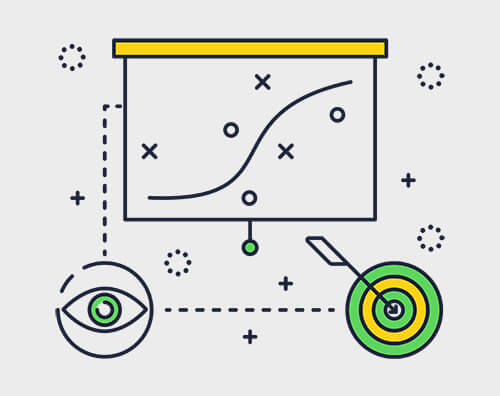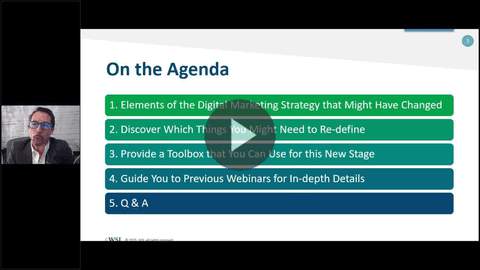We concluded our Ahead of the Curve webinar series with a thought-provoking presentation on Defining Your Post-COVID-19 Digital Marketing Plan. Carlos Guzman, one of our WSI Digital Marketing Consultants from Mexico City, did an amazing job of recapping the strategies and concepts we talked about over the last several weeks. During his session, he shared eleven steps to help guide you through revisiting your current digital marketing activities and making the necessary adjustments for today's marketplace.
We know that the company you went into this pandemic with from an operational and marketing perspective will be different AND should be different from the company that is coming out. Hopefully, some of the tips we have shared throughout our Ahead of the Curve webinars have helped you with this process of digital transformation.
If you happen to miss our last session, we have included a recap of the 11 steps to redefining your digital marketing plan below, along with a replay of the webinar.
#1: Review and Update Your Buyer Personas
The buyer personas you have defined for your business have most likely changed. Their problems, concerns, interests, and feelings have all been impacted by the pandemic, stay-at-home protocols, and social distancing. So, don't assume that your ideal target audience today is the same as the one you had identified pre-COVID. Take the time to review and update your current personas and focus on discovering any new personas that you may not have considered before. Meet up with your Sales and Customer Service Teams to gather their feedback based on the real conversations they are having with your prospects and customers and use it to help fuel updates to your buyer personas. If you want to dig into this further, watch the recording from our webinar on Understanding Your Target Audience in Challenging Times.
#2: Enhance Your Digital Marketing Intelligence
As the market recovers, new customer behaviors and trends will unfold. You must take some time to monitor the marketing trends in your market and industry and use this intelligence to detect new consumer patterns and business opportunities. If you aren't sure where to start, we recommend checking out Google Trends—it's a helpful (and free) tool for analyzing search trends.
#3: Get to Know Your Current/New Competition Online
The reality is, due to the pandemic, your competitor's landscape has changed. Some of your competitors may have disappeared, some may have reduced their marketing activities, some may have launched new products and services, and some new competitors may have come out of the woodwork. That's why conducting a new competitive analysis is an essential part of any post-COVID-19 digital marketing strategy. If you need a refresher on the types of research and digital marketing audits you should be doing as part of your competitive analysis, check out the recording from our webinar on How to Analyze the Marketing Activities of Your Competitors to Get Ahead.
#4: Validate Your Differentiation in the Market
So much has changed in today's business world that what used to make you stand out from your competitors, may not be a key differentiation anymore. We suggest tracking your website visitors and comparing your current user patterns to a set period before COVID to see if anything has changed. Or, conduct a website audit to help identify any new search habits that you need to consider as part of your broader marketing strategy.
#5: Redefine Your Business Goals
You will have established very targeted goals ahead of COVID, but these may have changed over the last few months. Make a point to review your original goals and make sure they are still valid and meaningful. In some cases, you may even need to add new goals to help you on the road to recovery. Remember that if you make any changes to your website goals, update your goal conversions in your Google Analytics as well so you can track this accurately.
#6: Close Monitoring of Your Customer Journey
With all the changes that may have happened to your buyer personas, competition, and the market, you'll want to track your customer journey closely to define specific actions for each stage of the funnel. Using technology like marketing automation can help you score your leads as they move from the top to the bottom of the funnel and help you identify opportunities for improvement.
#7: Revise Your Content Mix
As customers spend more time online and on social media, engaging content will be an essential aspect of any content strategy. We encourage businesses to leverage more videos, animations, webinars, and interactive tutorials as part of their overall content mix. Check out one of our previous blog posts, 7 Types of Videos to Build Your Brand, Business & Bottom Line, or our Ahead of the Curve webinar on video to get ideas on where you can add more engaging content throughout your business and improve your content marketing strategy.
#8: Identify Your Key Paid Advertising Channels
If your advertising channels include Google, Facebook, Instagram, and YouTube at the beginning of the year, these would most likely continue to be part of your primary digital media mix. But other channels may have surfaced since COVID-19 that you may also want to investigate and test. TikTok, for example, has become the new player in the social media world in terms of downloads and users. And while advertising on TikTok may not be the right fit for many brands right now, at the very least, all businesses should be reserving their TikTok handles, so they have them when they need them. Learn more about social media marketing.
#9: Invest in Organic Traffic and SEO
Search engine optimization (SEO) enables you to generate a constant stream of organic traffic to your website. Think of it as your insurance policy or your vaccine for the next time you may need to reduce or suspend your paid advertising campaigns. Companies generating organic traffic before the crisis and who continued to invest in SEO throughout the pandemic were less likely to see a drop off in their website visitors and online leads even if they happened to reduce their paid advertising spend.
#10: Leverage Your Customer Database
Your database of prospects and customers is your most valuable asset. To leverage it properly, you need a marketing automation solution that includes a robust CRM (client relationship management system) and a clearly defined email marketing strategy. Nurturing your database isn't about sending random emails here and there. It's about mapping out a plan that leverages automation to send your customers timely and relevant communications that encourage them to take action (and hopefully help you generate sales). If you need some further insights on how effective database management works, check out our Ahead of the Curve webinar recording on, Learning the Basics of Managing Your Customer Database to Grow Your Business.
#11: Build a Dashboard and View it Daily
There are so many metrics across your digital strategy that need to be monitored. The best way to stay on top of them is to create one dashboard that pulls all of your top KPIs (key performance indicators) together in one view. Think of this dashboard as your very friendly window to all of the analytics that you need to make key business decisions. There are many different tools that you can use to create this dashboard, so find the one that works for you and stick with it.
For more details on the eleven steps above, watch the recording from our webinar, Defining Your Post-COVID-19 Digital Marketing Plan (posted below).







